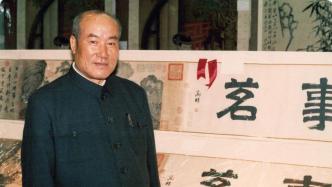
The importance of Qiantang River and West Lake to the formation and development of Hangzhou is self-evident.
But from the point of view of cultural relics and archaeology, the essence of Hangzhou lies first in the mountains. Among the mountains around the lake, there are many historical sites. From the archaeological point of view, the author of this paper takes the mountains of Hangzhou as the cut-in, and outlines the history of Hangzhou's establishment of the city for thousands of years.
The rivers, mountains, lakes and seas, the four natural factors, the importance of the Qiantang River and the West Lake to the formation and development of the city of Hangzhou, goes without saying.
But from the point of view of cultural relics and archaeology, the essence of Hangzhou lies in the mountains first. After all, the rivers and seas are constantly flowing, and the green hills are still there when the sun sets several times. Among the mountains surrounding the lake, there are many historical monuments.
one
The Laohe Mountain Site, as the name suggests, is located at the foot of the Laohe Mountain in what is now the Yuquan Campus of Zhejiang University. The site was discovered in early 1936 when the Hangzhou No. 1 Cemetery was built. On May 31 of the same year, the Wuyue Historical and Geographical Research Association and the West Lake Museum did a one-day cleanup. After participating in the excavation work, the young man was deeply inspired and inspired. Later, he discovered the Liangzhu cultural site in his hometown, which was enough to rewrite the history of Chinese civilization.
During the construction of the new campus of Zhejiang University in 1953, the East China Cultural Relics Team, together with the Zhejiang Provincial Museum (formerly the West Lake Museum) and the Zhejiang Provincial Cultural Relics Management Committee, carried out a large-scale rescue excavation. In addition to a large number of tombs from the Han and Six Dynasties to the Song and Yuan Dynasties, the There are many pottery and stone tools from the Neolithic Age. According to Mr. Mou Yongkang, who participated in the excavation work, the work was carried out under the scorching sun, and there were "relics of Majiabang culture, as well as the accumulation of Liangzhu culture and Maqiao culture" (Mu Yongkang's "Several Documents on Liangzhu and Majiabang Archaeology"). Memories - Commemorating the 40th Anniversary of the Discovery of the Majiabang Culture"), which is one of the earliest archaeological works officially carried out in Zhejiang after the founding of New China, excited young people have boundless curiosity.
Now we know that four or five thousand years ago, the ancient country of Liangzhu, centered on the "Liangzhu Ancient City" of Yuhang Ping Kiln, created a glorious ancient civilization. There are marginal contemporaneous settlements in sporadic locations such as Gudang near Laohe Mountain.
Perhaps the ancient city of Liangzhu can be regarded as the predecessor of Hangzhou. In 1977, Su Bingqi said a high-rise building in Liangzhu: "I originally wanted to say that Liangzhu is ancient Hangzhou. You can see that the terrain here is higher than Hangzhou, and the rest of Tianmu Mountain belongs to it. A natural barrier, Tiaoxi is an important passage to the outside world. It is a typical land of fish and rice in the south of the Yangtze River. Hangzhou should have started from here, and then gradually approached the mouth of the Qiantang River and stopped by the West Lake.” Looking back on the conversation more than 40 years ago, I sincerely appreciate the historical and geographical vision of Pei Sugong. In the long river of history, the development of urban centers is indeed fluid. But if you narrow your field of vision, in terms of the scope of the main urban area of Hangzhou today, then the foot of Laohe Mountain is the earliest Hangzhou.

Today's panorama of West Lake (Photo by Xu Chao)
two
Apart from the location of "the earliest Hangzhou", the largest cemetery of the two Han dynasties in Hangzhou has been discovered so far at the northern foot of Laohe Mountain. A bronze seal of "Zhu Lechang" was unearthed from a tomb of the Western Han Dynasty. (Jiang Zanchu, "The First Excavation of Laohe Mountain in Hangzhou in 1953"; Zhu Boqian, "A Brief Report on the Clearing of the Tomb of Zhu Lechang in the Ancient Han Dynasty in Hangzhou"). From the tombs of the Han and Six Dynasties in Laohe Mountain, Yuquan, and Yuefen, combined with the previous pre-Qin ruins, it can be determined that this is one of the earliest central settlements in Hangzhou. Jiabu (at the foot of Jilong Mountain) to Lingyin Temple, then go northeast along Lingfeng Mountain from Baile Bridge to Yuquan and Zhejiang University, then turn south along Zheda Road into Shuguang Road and Xishan Road to West Lake Hotel (i.e. Liuzhuang) area It is a good place for human beings to multiply and live.” (Lin Huadong, “Research and Identification of the Former Site of Qian and Tang Dynasties”).
Qiantang County in Kuaiji County is the first batch of counties implemented in the territory after Qin Shihuang unified the six kingdoms, and it is also the direct source of Hangzhou. The county seat of Qiantang County in the Qin Dynasty was located on the first line of Lingyin Mountain. There are not only the documentary records of "The County is under Lingyin Mountain, and the base still exists" in the Southern Dynasties Qiantang County Magistrate Liu Zhendao's "Qiantang Ji", as well as the evidence of archaeological discoveries, which is also consistent with everyday life experiences of ordinary people. Today's Hangzhou City used to be the old route of the river and the sea. It was close to the big river, and the groundwater was bitter and bad. Before the Tang Dynasty, the tidal flats and flats of the river were not suitable for people to live in. Only the foothills and terraces of moderate heights, there were mountain springs to drink, and they were not flooded by floods, which were suitable for the formation of settlements. Then it developed into a county-level city.
The Xihubei Mountain on the line from Lingyin to Yuefen is such a good place. In addition to the Laoheshan site, the hotel construction site outside Yuefen (now the Shangri-La Hotel, Hangzhou) is said to have found relics from prehistoric to the Han Dynasty (Wang Shilun's "Looking at Ancient Hangzhou from Unearthed Cultural Relics"). culture"). However, from the archaeological data currently available, during the Shang and Zhou dynasties, Hangzhou had only sporadic and lower-level relics and relics. In terms of the degree of social development, it still lags behind the Yuhang District in the north, such as the small ancient city site of Panqiao Town in Yuhang. The Maqiao Culture (about the Central Plains Xia and Shang Dynasties) settlements and the large-scale Warring States to early Western Han cemeteries discovered in Yuhang Town in the past ten years have never been seen in Hangzhou urban area.
During the pre-Qin period, the archaeological discoveries closest to the urban area of Hangzhou occurred in the mid-level area. In 1990, the two Warring States aristocratic tombs in Shitang Village, Banshan were one of the largest pre-Qin tombs in Zhejiang Province. Although they were stolen, there were still more than 30 original porcelain musical instruments, among which the crystal cups were particularly miraculous and could be called national treasures. According to the excavators' speculation, the owner of the tomb should be a local "chief executive or military leader"; the chief may most likely be the local county official; since the county official is buried in the middle of the mountain, the county seat should also be nearby (Du Zhengxian, "The Former Site of Qian and Tang Dynasty" Exploring"). What county is this? It should be an unnamed "county" set up on the north bank of the Qiantang River after the Chu State destroyed Viet Nam. As the old county of the Chu State, it was inherited by the Qin Dynasty and named Qiantang County. This is a reasonable speculation by archaeologists based on new archaeological discoveries. As for why Qinzhi Qiantang County moved from the mid-levels to the foot of Lingyin Mountain, it is impossible to speculate further.
three
According to Liu Zhendao's "Qiantang Ji", "the anti-sea big pond is located in the east of (Qiantang) County, and the county councilor Cao Huaxin proposed to build this pond to prevent sea water." In the Eastern Han Dynasty, there was a man named Huaxin, who built a seawall to defend the Qiantang River in a place about one mile east of Qiantang County.
As a milestone in the land development process between the east of the West Lake and the Qiantang River, the Huaxin Seawall is a major event in the history of Hangzhou's urban development. The Huaxin Seawall must be within the current urban area, and the mainstream view is that it is now Zhongshan Road in Hangzhou. One mile, about four or five hundred meters, is very close. If Qiantang County is located in Lingyin Mountain or Laohe Mountain west of West Lake, the distance to Zhongshan Road will not be more than that. Therefore, everyone believes that Qiantang County has moved from Lingyin to the foothills of Baoshi Mountain at this time. The distance from Baoshan Mountain to Zhongshan Road is about one mile.
Scholars mainly rely on the phrase "the Fanghai Datang is in the east of the county". First, from the fact that Qiantang County was located in the northeast of West Lake during the Tang and Song Dynasties, it is inferred that Qiantang County first moved from Lingyin to the east foot of Baoshi Mountain, and then it is inferred that Huaxin Seawall is now Zhongshan Road, and then Zhongshan Road is reversed to sit on Shishi County. Shandong foothills. If there is no archaeological evidence, it is logically an endless cycle, but it is in line with the basic trend and facts of Hangzhou's urban development, because the Qiantang county government in the Sui and Tang Dynasties is indeed in the area of the present-day Baoshi Mountain. From the fact that the descendants, it is inferred that the county government must have been from the mountain. In the process of moving out, the relocation activity took place before and after Huaxin Li Haitang, which was logically self-consistent and reasonable.
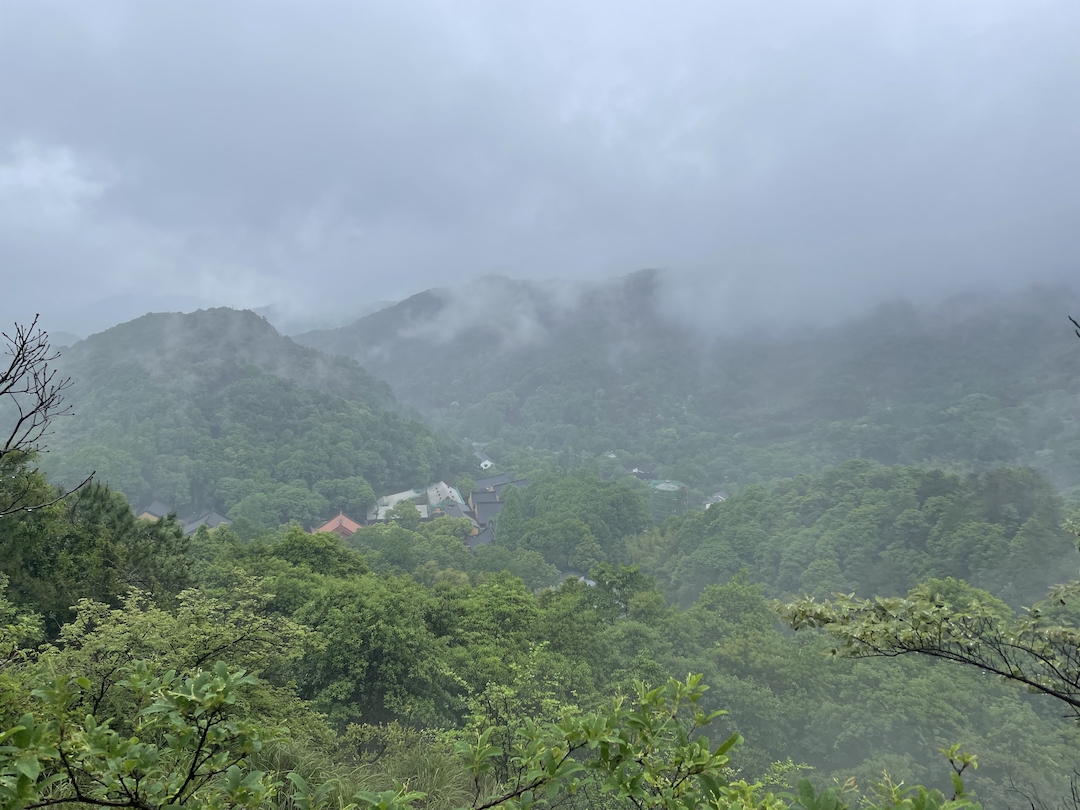
Overlooking Shangtianzhu (Faxi Temple) from Tianzhu Mountain
The area around the eastern foothills of Baoshi Mountain is Yima Pingchuan today. Historically, there are many rolling hills. There are some hills between the Hangzhou Children's Palace (the former Zhaoqing Temple) and the present provincial government compound. It is called Wulin Mountain (nearby the Wulin Gate of the North Gate of Hangzhou City, hence the name). Huoshan is not high, but its status is respected. It is known as the ancestor of the mountains in Hangzhou. After the Eastern Han Dynasty, the county seat of Qiantang was near here.
Strange to say, the county seat of four or five hundred years does not even have any important archaeological remains. It is said that at the beginning of the Republic of China, "there were tombs of people who destroyed and dug graves on the side of the precious stone mountain. At first, they were the tombs of the neighbors, and then there were the tombs of the Song people, and then there were the tombs of the Jin people. It has been piled up for thousands of years." (Zhong Yulong, " Talking about Hangzhou, Talking about the Land"). There are many clues in the Internet and public word-of-mouth. From the Mituo Mountain to the Dujinsheng Brocade Factory and the Wanghu Hotel near the Sixth Park, cultural relics such as the Eastern Han well, Han and Jin bricks and celadon ware have been discovered over the years (Lin Yingying, Lin East China's "Re-discussion on the Former Site of Qiantang County in the Qin and Han Dynasties"), but there has never been a scientific archaeological investigation and excavation report published.
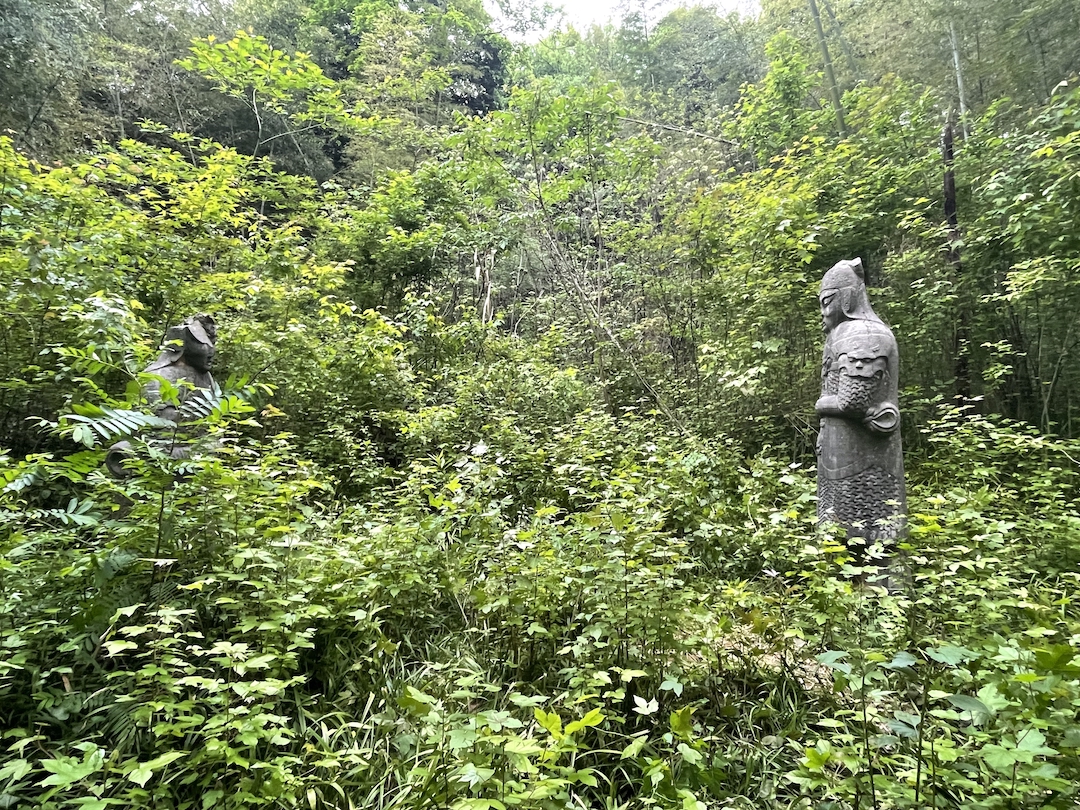
The stone statues of Song and Ming Dynasties scattered on the mountain behind Lingyin Temple
In Hangzhou during the Qin, Han and Six Dynasties, Tan Qixiang's "The History of Hangzhou Urban Development" is called "the era of small county in the mountains". The early history of Hangzhou can be regarded as a history of changes in mountain settlements, first from north to south, from Yuhang to Hangzhou, and then from west to east, from the deep mountains west of the West Lake to the low mountains and hills east of the lake.
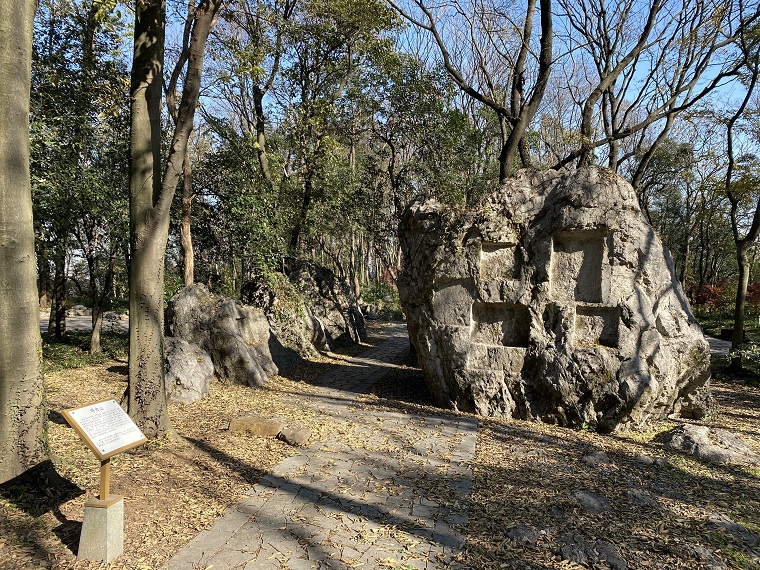
Dispose of Taishan Yashi
Among the mountains around the lake, the Pai Ya Stone on the top of Taishan and the Lotus Peak on the top of Feilai Peak should be the two highest places with the highest cliff stone carvings in the Tang and Song Dynasties, because the former is adjacent to the Hangzhou Tang and Song Government Office of Phoenix Mountain, and the latter is the spiritual Zhu Shanshui has been a Buddhist holy place and a popular scenic spot since the Jin and Tang dynasties. As for other higher and more remote mountain peaks, such as Shili Langjing, Shirenling, Tianmen Mountain and other places, the journey was really difficult for the literati and writers of the Tang and Song Dynasties, but Bai Juyi and Su Dongpo did not reach them. In the Qing Dynasty, there was a saying that the county seat of Qin, Qiantang and Tang was in Sushan (Shirenling), but the mountains were high and the road was far away. In the Tang and Song Dynasties and even modern times, it was still desolate and unsuitable for living. It was impossible to serve as the county seat in the Qin and Han dynasties.
Four
During the Sui, Tang and Five Dynasties, Hangzhou, Tan Qixiang called it "the era of Jianggan Dajun". The most important place in Jianggan is Liupu. Liupu is located on the north bank of Qiantang River at the foot of Fenghuang Mountain, across the river from Xiling (now Xiaoshan Xixing) on the other side.
In the ninth year of Emperor Kaihuang of Sui Dynasty (589), after Sui Ping Chen, the county was abolished and the state was established, and the name of Hangzhou officially appeared in history. Two years later, a prefectural government was established at the foot of Fenghuang Mountain in the west of Liupu. This small town with "nine miles around" is the sub-city from the Sui, Tang and Five Dynasties to the Northern Song Dynasty, and later the imperial city of the Southern Song Dynasty.
The name of Phoenix Mountain sounds ordinary, but it is actually a tall limestone mountain. In terms of livability, it may not be better than the foothills of Gem Mountain. The main reason for building the city on the mountain is strategic consideration, because occupying the commanding heights of Liupudu and its vicinity is equivalent to strangling the throat between the two Zhejiang.
Bai Juyi's poem "Yuhang's Shape and Victory" says: "Yuhang's shape is better than nothing in the world, and the state is pillowed by Qingshan County and the lake." Hangzhou in the Tang Dynasty, the south is the state city (Zicheng) at the foot of the Phoenix Mountain in Jianggan, and the north is the Qiantang County at the foot of the precious stone mountain. With this sentence as the title of the book, it can be said to be enlightened. Chen Zhijian said that Hangzhou in the Tang Dynasty was a layout of two small cities, the "state city" and the "county city", and staged a "Tale of Two Cities", which was still the case until Bai Juyi was appointed as the prefect of Hangzhou during the Changqing period (821~824). Chen Zhijian's research on the urban history of Hangzhou before the Southern Song Dynasty is extremely wonderful. In this article, I would like to express my three compliments.
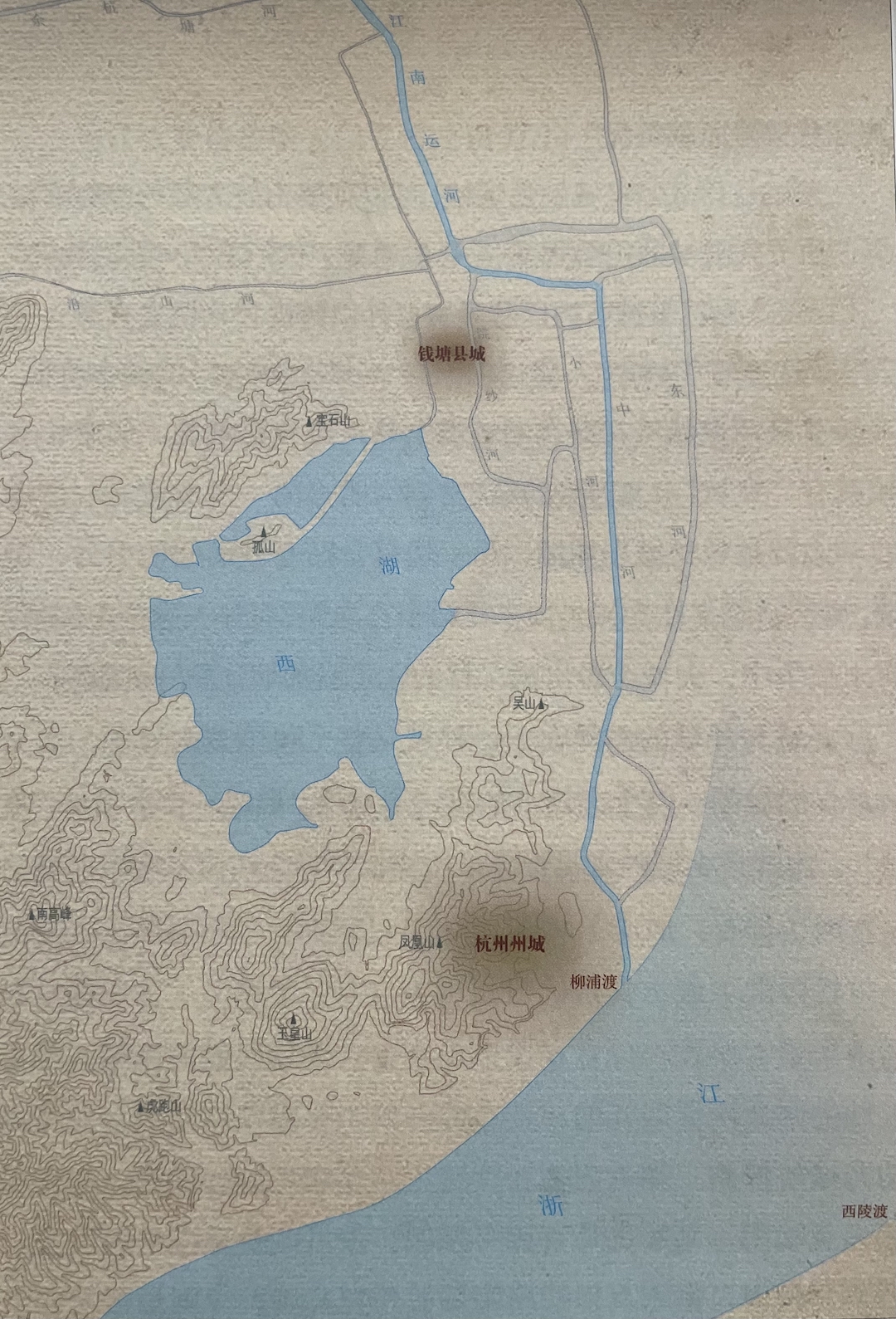
Hangzhou City and Qiantang County in Sui and Tang Dynasties
Tang and Song Zicheng (the imperial city of the Southern Song Dynasty) "surrounded by nine li", the scale is not small, the city walls, government offices, pavilions and pavilions have been lost for less than a thousand years. The Municipal Institute of Cultural Relics and Archaeology has explored the ruins of the imperial city, and the preservation is acceptable. The biggest feature of Zicheng is "building a city according to the mountains", while Phoenix Mountain is a steep mountain, and there are not many flat terraces between the valleys for construction. In 2019, I went to the west side of the imperial city to inspect the archaeological site of Shengguo Temple (the Southern Song Dynasty was changed to Dianqiansi, and there was a "faithful" cliff of Song Gaozong among the rock walls). More than a year later, it is eye-opening - today's ground is very high, and you can reach the "faithful" cliffs and the statues of the Eighteen Arhats of Wuyue Kingdom, while the foundation of the temple in the Wuyue Kingdom period is already 5.72 meters deep underground, while the Sui and Tang Dynasties are underground. The ground of the period is still buried deeper. For more than a thousand years, the land has been revived and abandoned repeatedly, and the ground has been continuously raised. Today, we are standing on the ground at least 6 meters higher than that in the Sui and Tang Dynasties.
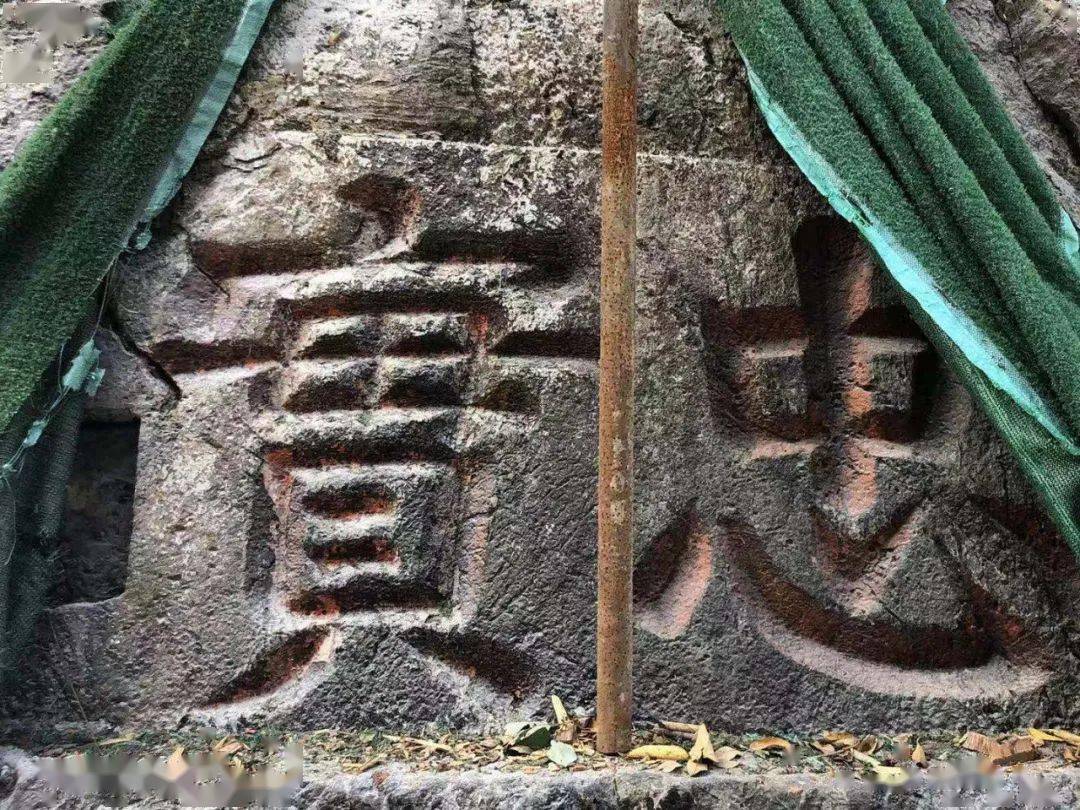
Song Gaozong Zhao Gou's regular script "faithful" on the cliff (picture from the Internet)
The ruins of Shengguo Temple are a microcosm of Fenghuang Mountain. There is reason to believe that the core area of the ruins of the imperial city in the Southern Song Dynasty was probably filled and lifted after countless ramming and demolition since the ninth year of Emperor Wen of the Sui Dynasty (589). up. The process of surface uplift at the foot of Phoenix Mountain is the development process of Hangzhou Zicheng.

"West Lake Map" attached to "Xianchun Lin'an Zhi" in the Southern Song Dynasty (repainted by Jiang Qingqing)
It is a pity that today people do not see the grand occasion of the Tang and Song Zicheng and the Southern Song Imperial City, but the palace paintings of the Southern Song Dynasty may partially satisfy our imagination. In the depths of the clouds and mists in the middle of Ma Yuan's "Ta Ge Tu", a looming pine forest hides a magnificent building complex, and a city wall at the edge of the clouds is generally considered by art historians to be a scene in the imperial city of the Southern Song Dynasty. Ma Lin's "The Night Moon on a Terrace" and Ma Yuan's "Carved Terrace Looking at the Clouds" and other small pieces of fans, mountains, pavilions, trees, and an empty sky, the scenes painted by the painter may also be a corner of the imperial city in the Southern Song Dynasty.

Ma Yuan's "Treading Songs"
Perhaps readers will say that the mountain peaks that painters in the Southern Song Dynasty used to express by the technique of "splitting the axe" are too steep, strange, and abrupt, unlike the beautiful landscapes in the south of the Yangtze River that people usually imagine. But if we ever took the Bapan Mountains and went straight to the top of the mountain, we would definitely feel the steepness of Phoenix Mountain and be impressed by the generalization and sublimated artistic expression of the painters of the Southern Song Dynasty on the basis of realism.
Phoenix Mountain is magical. The real mountains in the mountainous areas of southern Zhejiang are not as agile as hers, and the rockery carved by the water villages in northern Zhejiang is not as natural as hers. If there is a disadvantage, it is the limestone mountainous area, which has a lot of rain and fog, and the northern dignitaries who travel south are not suitable for it. Hangzhou is called a "humid place", and many princes of the Southern Song Dynasty died prematurely, which is said to be related to the humid environment in the mountains. But Fenghuang Mountain is by no means lowly. Anyone who has studied the palace paintings of the Southern Song Dynasty and has climbed Fenghuang Mountain (Fengshan) and Yuhuang Mountain (Longshan) knows that this is a group of strange mountains, and the smoke written by Xia Gui and Ma Yuan is filled with smoke. The landscape of the lake is not exactly the portrayal of lakes and mountains.
five
The hinterland between the north and south cities in the Tang Dynasty, that is, the main urban area of Hangzhou today, is far from the foothills of the mountain and close to the Qiantang River, so drinking water is very problematic. Until the Tang Jianzhong period (780~783), the prefect Li Bi opened six wells and guided the water of the West Lake into the city.
In AD 893, Qianliu established the Dacheng (Luocheng), which included Zicheng, Qiantang County and the "main urban area". The process of building the city of Hangzhou is to complete the two ends first, and then connect the middle, so it presents a waist drum shape with thicker north and south ends and a slightly thinner middle, so it is called "Waist Drum City". In 910, Qian Liu built a seawall outside the east city wall, so that the tide never invaded the city. After nearly 100 years of operation of Qian's Wuyue Kingdom, this Yaogu City finally became "the first state in the southeast of China" , and reached its peak in the period of Lin'an City in the Southern Song Dynasty.
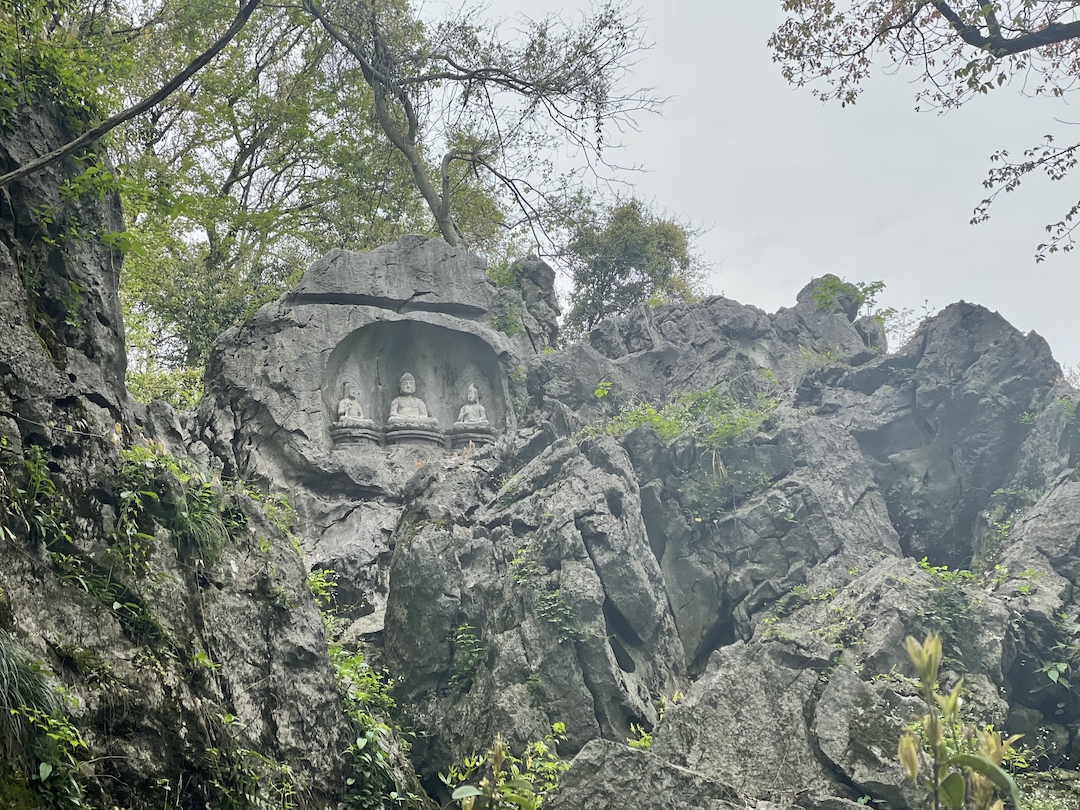
Statues of the Three Saints in the West during the Wuyue Kingdom Period on Feilai Peak
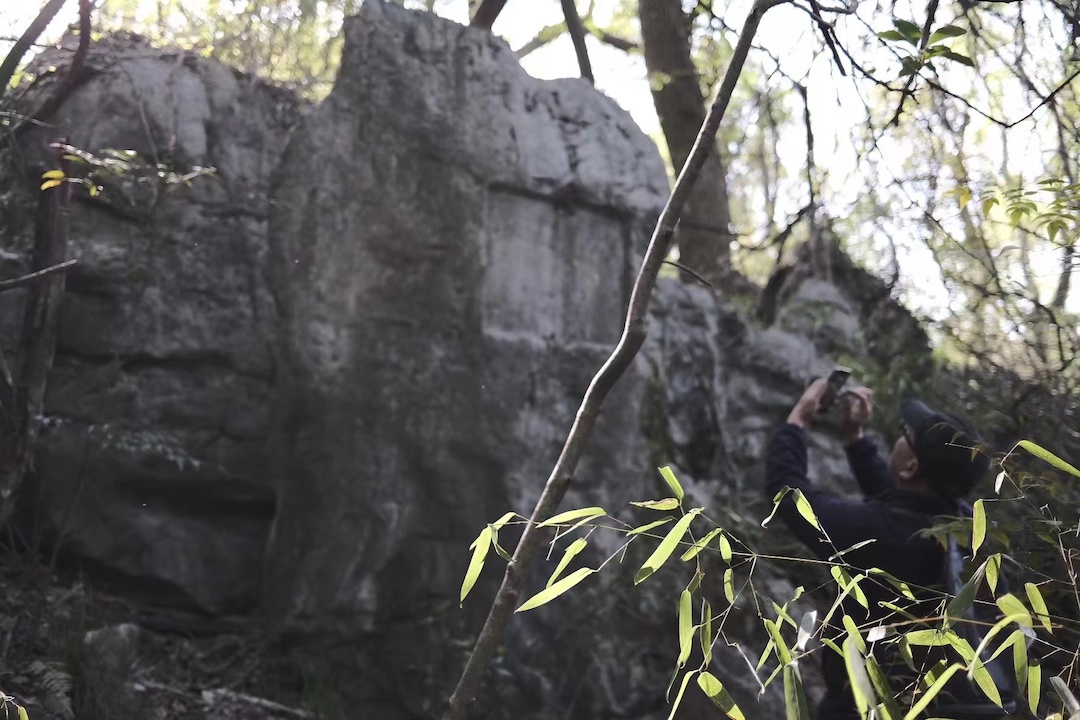
Looking for inscriptions on the cliffs in the wild mountains of West Lake
With the increasing population and high development of the main urban area east of the West Lake, the status of Phoenix Mountain in urban life has gradually decreased. After the Yuan Dynasty destroyed the Southern Song Dynasty, the city wall was demolished, and the imperial city was also destroyed. Since the Wuyue Kingdom in the Five Dynasties, the urban area has gradually become the center of daily life in the city. However, due to the characteristics of the "overlapping ancient and modern" cities, the urban relics since the Tang and Song dynasties have been buried deep underground. deep. It is difficult to see early historical sites in the main urban area today, such as the real relics of the Tang and Song Dynasties, such as Ciyunling, Yanxia Cave, Shiwu Cave, the Buddhist statues of Wuyue Kingdom in Jiuyao Mountain, Nanping Mountain, Feilai Peak, and Pai Ya Stone. Song Moya's inscription is hidden in the mountains surrounding the lake. And go to the mountains, there is a good scenery in the mountains.
six
Since Phoenix Mountain was abandoned outside the city, Wu Mountain was the only mountain in Hangzhou in Ming and Qing Dynasties. Wushan is a big article. Here we only talk about the strange stones of Ruishi Cave. People who often come to Wushan are destined to like the stones here.
Like Phoenix Mountain and Feilai Peak, Wushan Mountain is also a typical limestone mountain. Lu You's "Spring Tour of West Lake" "before Lingyin, after Tianzhu, ghosts cut out the gods and cut out the rocks" , Zhang Dai's "West Lake Dream Search" described Feilai Peak as "edge -shaped". The layers are clear and the inlay is exquisite, it is a strange stone in the sleeve of Mi Dian" , which can also be used to describe the Ruishi Cave in Wushan. The difference is that Lingzhu was a popular scenic spot in the Tang and Song Dynasties, while the Ruishi Cave of Ziyang Mountain (part of Wu Mountain), adjacent to the Taimiao Temple in the Southern Song Dynasty, was a forbidden area for the imperial court. , ordinary civilians must have no chance to appreciate the strange peaks and rocks here.
After the Song and Yuan Dynasties, this place gradually opened up. Zhou Mi's "Guixin Miscellaneous Knowledge" said that he walked from Yuegu Spring in Qingyi Cave to Ruishi Cave, and saw the Moon Wave Pool and Feilai Stone. dare not move forward. Could it be that Wushan at the turn of the Song and Yuan Dynasties was really so desolate? Yuan Dynasty poet Sadu Lai "Wu Shan Ziyang Nunnery" poem: "The wind blows me to the peak of Ao, the mountains and hills are exquisite. The red agate is baked in the red sun, the white dew drips green hibiscus at night. The wind blows the purple bamboo. When the crown is put on it, "Return" is written, and the tea is cooked in the camp lantern cave." Ruishi Cave has become a favorite object of officials and literati, and has been named "Purple Agate" and "Green Hibiscus".
Emperor Qianlong visited the Ruishi Cave frequently during his southern tour, and wrote poems and praises for "Feilai Stone". My love for Ruishi Cave is not under Lingyin Feilai Peak, because every strange stone here, such as Cuibi, Shouxing, Aofeng, Chuiyun, Purple Agate, Qing Furong, etc., has an appropriate and elegant name. And in the appropriate part of the stone, engraved with the title of the font, size, density and arrangement. The title and the strange stone are integrated together, just like "Deng Tuzi's Lustrous Fu" describes a beautiful woman as "too long if it is increased by one part, too short if it is reduced by one part, too white when powdered, and too red when applied to Zhu" . The sense of proportion is just perfect.
I greatly admire the aesthetic paradigm created by the stone and the title. However, there is no inscription on the inscriptions of the strange stones in Ruishi Cave, and the age is unknown. Hangzhou literature and historians mostly based on the poem "You Wushan Ziyang Nunnery" by Sadula, which tied this group of stone carvings to the Yuan Dynasty. But the inscriptions of Sadhula’s poems and the age of the stone carvings are not the same thing: perhaps before Sadhula, these stones already had a good name; the good name passed down by word of mouth does not necessarily have to be inscribed on the stone, just like Wushan twelve zodiac stones, each stone has a name familiar to the old Hangzhou, but they have not been engraved on it so far.
If you can’t judge the age of the cultural relics, you can’t talk about research, let alone write an article. Every time I go to Ruishi Cave, I feel sorry. In the thirty-first year of the Wanli reign of the Ming Dynasty (1583), Fan Lai, the governor of Zhejiang Province, wrote the "Ziyang Nunnery", which records the shape and spatial relationship of the Ziyang Nunnery and the strange stones near Ruishi Cave. So clear and specific. Fan Lai knew everything about the grass, trees, mountains and rocks in Ruishi Cave. Later, I read a piece of material in Ding Bing's "Wulin Fangxiang Zhi", and I suddenly realized that Fan Lai not only wrote this article, but also he is the author of the inscription of the strange stone. According to the Qing Dynasty Yao Jing "West Lake Chronicle": "Wanli three In the eleventh year, Chief Secretary Shi Jichen and Fan Lai built Xiu Shi Tang and Yuan Lan Hall. There are many scenic spots in the mountains, such as Zhizhi Rock, Medicine Garden, Difan Pond, Xunzhen Road, Chengdao Tree, Songguan, and Clothes Repairing. Stone, Green Lotus, Guiyun Cave, Teana Valley, Sandai Stone, Ziyang Pavilion, ... Ruishi Cave, Feilai Stone, Dragon Cave, Aofeng, Emerald Rock, Chuiyun Peak, Moon Wave Pool, Toad Stone, Squat Lion Rock, Pill Stove, Cuibi, Yingzhen Bridge Cave, Chaoyuan Road, Toutian Pass etc. Fan Gong (Fan Lai) knows all about it, he re-authored "Ziyang Immortal Traces", painted its pictures, In the empty and green pavilion, there are also famous poems and stones." (Ding Bing, "Wulinfang Lane Zhi Fengxiafang III Ziyang Nunnery"). The title of this batch of strange stones, the relationship between the name and the real, has been fixed, and we can now follow the map to identify the stones named Chuiyunfeng, Shouxingshi, and Huhuofeng one by one. The name of the strange stone is very image; the calligraphy of the title is very quiet, which reflects the ingenuity of ancient man-made landscapes and endows nature with immortal humanistic aesthetic value.
I take the trouble to describe the strange stones of Wushan because of the special significance of the mountains around the lake in the history of Chinese gardens. The Genyue built by Song Huizong in Bianjing simulates Phoenix Mountain; Song Gaozong retreats to Deshou Palace in Lin'an City, and its garden simulates Lingyin Feilai Peak and Lengquan Stream. Phoenix Mountain, Wushan Mountain, and Feilai Peak are the most important models of royal gardens in the Song Dynasty, and they are probably also one of the sources of inspiration for the aesthetic paradigm of "stacking mountains and managing water" in gardens at that time.
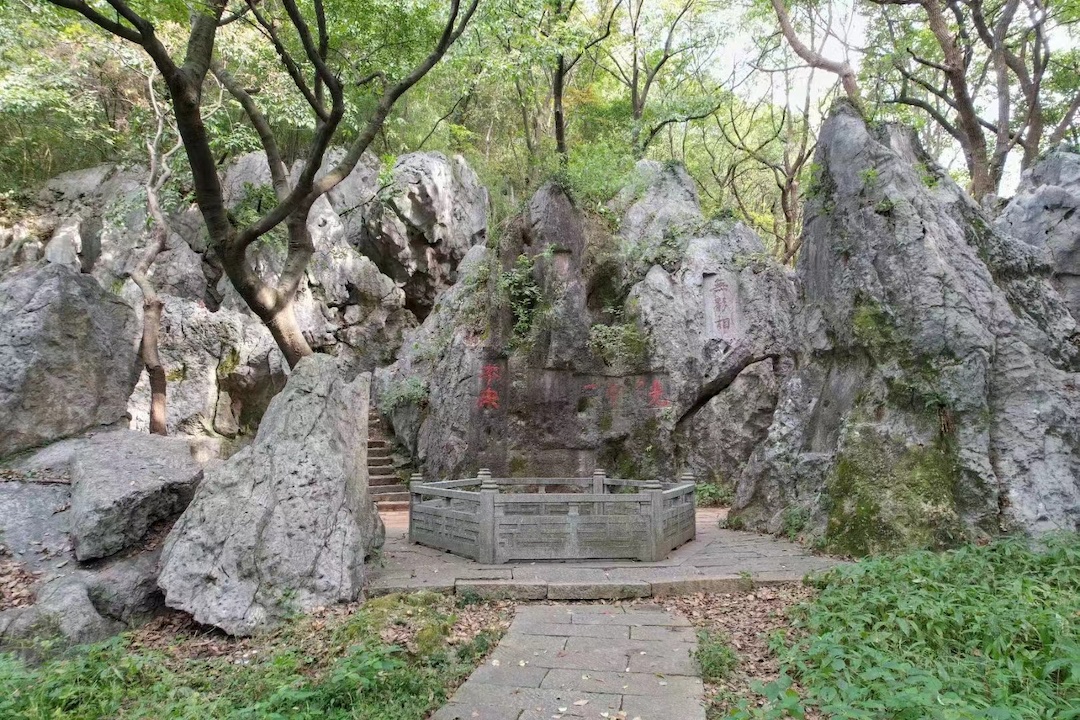
Moon Rock in Phoenix Mountain
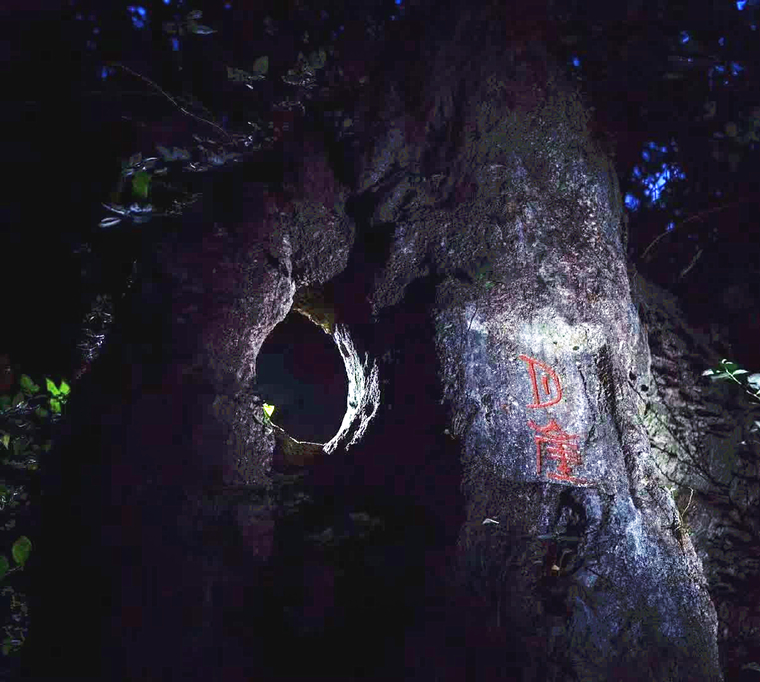
moon cliff
The Moon Rock near the Shengguo Temple in Phoenix Mountain, on the Mid-Autumn Festival night, the full moon passes over the strange rock, and it is a popular place for viewing the moon in the imperial city of the Southern Song Dynasty. Gao Lian, a talented person from Hangzhou during the Wanli period of the Ming Dynasty, wrote "The Four Seasons Recognition Records: Shengguo Temple Moon Rock Watching the Moon" is a good article:
On the left side of Sheng (Saint) Fruit Temple, there is a stone wall on the mountain, and there is a sinus in the middle, which is as round as a mirror. The full moon in the Mid-Autumn Festival, and the gap is shot, looking at it from the sinus, the light is like a wall. In autumn, when drinking friends with Shi Peng, Geng He Qing, and listening to the sound of the Wanhe River, the sky is full of sea and the sea, and it feels like playing with the moon outside the world. The left is the old Song Yujiao field, where the pro-military guards, the important land in the country, is now a desolate and remote area! How is the mirror gap, cloudy and sunny, always full, no loss for eternity, only ups and downs, all into this stone eye, the world is teasing, secretly laughing coldly.
Phoenix Mountain, Moon Rock, the West Lake on the left, Qianjiang River on the right, craggy rocks, the ebb and flow of the river, the pines of the valley, the Mid-autumn night, drinking friends with three or two poets, Genghe Qingshang, the important place in the Southern Song Dynasty, Today's desolate wilderness. Infinite scenery, endless sighs.
The surrounding mountains and lakes are the places that scholars and officials yearn for, and also the direction for ordinary people in Hangzhou to go back. Ming Wanli "Hangzhou Fuzhi" volume nineteen "customs" said that Hangzhou's two north and south mountains are "where the graves of millions of residents" . Archaeologists pay attention to tombs, but they are not popular, so I will stop here, but the close connection between the mountains around the lake and the lives and emotions of Hangzhou citizens is an conceivable fact.
The mountains around the lake have multiple historical, humanistic and artistic aesthetic values for the development of the ancient city and culture of Hangzhou. I said that the essence of Hangzhou is in the mountains, and it is not appropriate!

"Seeing the Song Dynasty in the Field" (Zhejiang Ancient Books Publishing House, 2022)
(This article is included in "Seeing the Song Dynasty in the Fields" recently published by Zhejiang Ancient Books Publishing House. The Paper is authorized to publish. The author is the deputy director of the Zhejiang Provincial Institute of Cultural Relics and Archaeology)
